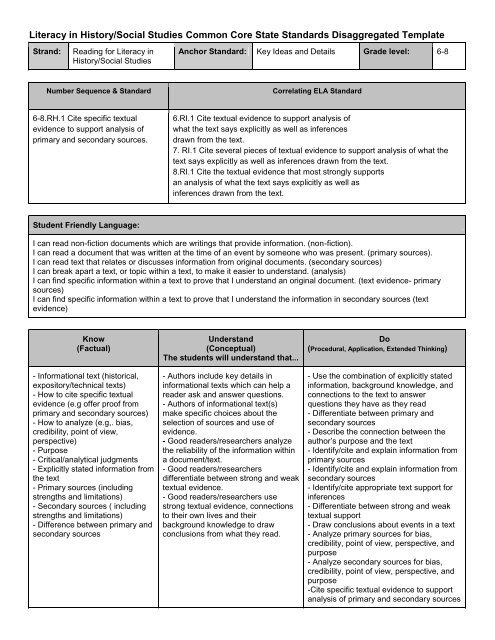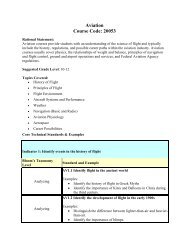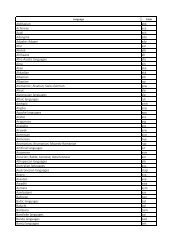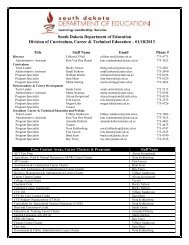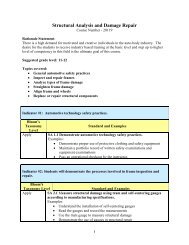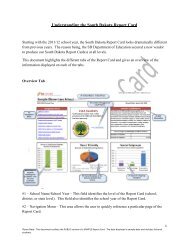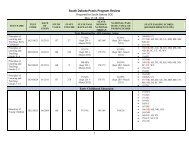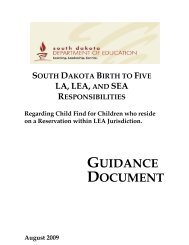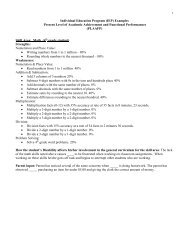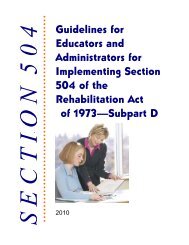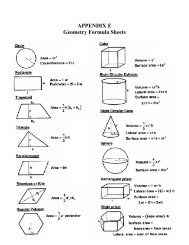Literacy in History/Social Studies Common Core State Standards ...
Literacy in History/Social Studies Common Core State Standards ...
Literacy in History/Social Studies Common Core State Standards ...
You also want an ePaper? Increase the reach of your titles
YUMPU automatically turns print PDFs into web optimized ePapers that Google loves.
<strong>Literacy</strong> <strong>in</strong> <strong>History</strong>/<strong>Social</strong> <strong>Studies</strong> <strong>Common</strong> <strong>Core</strong> <strong>State</strong> <strong>Standards</strong> Disaggregated Template<br />
Strand:<br />
Read<strong>in</strong>g for <strong>Literacy</strong> <strong>in</strong><br />
<strong>History</strong>/<strong>Social</strong> <strong>Studies</strong><br />
Anchor Standard: Key Ideas and Details Grade level: 6-8<br />
Number Sequence & Standard<br />
Correlat<strong>in</strong>g ELA Standard<br />
6-8.RH.1 Cite specific textual<br />
evidence to support analysis of<br />
primary and secondary sources.<br />
6.RI.1 Cite textual evidence to support analysis of<br />
what the text says explicitly as well as <strong>in</strong>ferences<br />
drawn from the text.<br />
7. RI.1 Cite several pieces of textual evidence to support analysis of what the<br />
text says explicitly as well as <strong>in</strong>ferences drawn from the text.<br />
8.RI.1 Cite the textual evidence that most strongly supports<br />
an analysis of what the text says explicitly as well as<br />
<strong>in</strong>ferences drawn from the text.<br />
Student Friendly Language:<br />
I can read non-fiction documents which are writ<strong>in</strong>gs that provide <strong>in</strong>formation. (non-fiction).<br />
I can read a document that was written at the time of an event by someone who was present. (primary sources).<br />
I can read text that relates or discusses <strong>in</strong>formation from orig<strong>in</strong>al documents. (secondary sources)<br />
I can break apart a text, or topic with<strong>in</strong> a text, to make it easier to understand. (analysis)<br />
I can f<strong>in</strong>d specific <strong>in</strong>formation with<strong>in</strong> a text to prove that I understand an orig<strong>in</strong>al document. (text evidence- primary<br />
sources)<br />
I can f<strong>in</strong>d specific <strong>in</strong>formation with<strong>in</strong> a text to prove that I understand the <strong>in</strong>formation <strong>in</strong> secondary sources (text<br />
evidence)<br />
Know<br />
(Factual)<br />
- Informational text (historical,<br />
expository/technical texts)<br />
- How to cite specific textual<br />
evidence (e.g offer proof from<br />
primary and secondary sources)<br />
- How to analyze (e.g,. bias,<br />
credibility, po<strong>in</strong>t of view,<br />
perspective)<br />
- Purpose<br />
- Critical/analytical judgments<br />
- Explicitly stated <strong>in</strong>formation from<br />
the text<br />
- Primary sources (<strong>in</strong>clud<strong>in</strong>g<br />
strengths and limitations)<br />
- Secondary sources ( <strong>in</strong>clud<strong>in</strong>g<br />
strengths and limitations)<br />
- Difference between primary and<br />
secondary sources<br />
Understand<br />
(Conceptual)<br />
The students will understand that...<br />
- Authors <strong>in</strong>clude key details <strong>in</strong><br />
<strong>in</strong>formational texts which can help a<br />
reader ask and answer questions.<br />
- Authors of <strong>in</strong>formational text(s)<br />
make specific choices about the<br />
selection of sources and use of<br />
evidence.<br />
- Good readers/researchers analyze<br />
the reliability of the <strong>in</strong>formation with<strong>in</strong><br />
a document/text.<br />
- Good readers/researchers<br />
differentiate between strong and weak<br />
textual evidence.<br />
- Good readers/researchers use<br />
strong textual evidence, connections<br />
to their own lives and their<br />
background knowledge to draw<br />
conclusions from what they read.<br />
Do<br />
(Procedural, Application, Extended Th<strong>in</strong>k<strong>in</strong>g)<br />
- Use the comb<strong>in</strong>ation of explicitly stated<br />
<strong>in</strong>formation, background knowledge, and<br />
connections to the text to answer<br />
questions they have as they read<br />
- Differentiate between primary and<br />
secondary sources<br />
- Describe the connection between the<br />
author’s purpose and the text<br />
- Identify/cite and expla<strong>in</strong> <strong>in</strong>formation from<br />
primary sources<br />
- Identify/cite and expla<strong>in</strong> <strong>in</strong>formation from<br />
secondary sources<br />
- Identify/cite appropriate text support for<br />
<strong>in</strong>ferences<br />
- Differentiate between strong and weak<br />
textual support<br />
- Draw conclusions about events <strong>in</strong> a text<br />
- Analyze primary sources for bias,<br />
credibility, po<strong>in</strong>t of view, perspective, and<br />
purpose<br />
- Analyze secondary sources for bias,<br />
credibility, po<strong>in</strong>t of view, perspective, and<br />
purpose<br />
-Cite specific textual evidence to support<br />
analysis of primary and secondary sources
Key Vocabulary:<br />
analysis, central idea, textual evidence, explicit, primary source, secondary source<br />
Relevance and Applications: How might the grade level expectation be applied at home, on the job or <strong>in</strong> a real-world,<br />
relevant context? Include at least one example stem for the conversation with students to answer the question “why do<br />
I have to learn this”?<br />
Students need to be able to validate their assumptions based on textual evidence. For example, when mak<strong>in</strong>g the<br />
purchase of a cell phone, a consumer would need to evaluate the choices available and make a decision based on the<br />
sales <strong>in</strong>formation.
<strong>Literacy</strong> <strong>in</strong> <strong>History</strong>/<strong>Social</strong> <strong>Studies</strong> <strong>Common</strong> <strong>Core</strong> <strong>State</strong> <strong>Standards</strong> Disaggregated Template<br />
Strand:<br />
Read<strong>in</strong>g for <strong>Literacy</strong> <strong>in</strong><br />
<strong>History</strong>/<strong>Social</strong> <strong>Studies</strong><br />
Anchor Standard: Key Ideas and Details Grade level: 6-8<br />
Number Sequence & Standard<br />
6-8.RH.2 Determ<strong>in</strong>e the central ideas or <strong>in</strong>formation of a<br />
primary or secondary source; provide an accurate<br />
summary of the source dist<strong>in</strong>ct from prior knowledge or<br />
op<strong>in</strong>ions.<br />
Correlat<strong>in</strong>g ELA Standard<br />
6.RI.2 Determ<strong>in</strong>e a central idea of a text and how it<br />
is conveyed through particular details; provide a summary<br />
of the text dist<strong>in</strong>ct from personal op<strong>in</strong>ions or judgments.<br />
7. RI.2 Determ<strong>in</strong>e two or more central ideas <strong>in</strong> a text and<br />
analyze their development over the text and provide an<br />
objective summary.<br />
8.RI.2 Determ<strong>in</strong>e a central idea of a text and analyze its<br />
development over the course of the text, <strong>in</strong>clud<strong>in</strong>g its<br />
relationship to support<strong>in</strong>g ideas; provide an objective<br />
summary of the text.<br />
Student Friendly Language:<br />
I can determ<strong>in</strong>e (figure out) the central idea (theme or ma<strong>in</strong> po<strong>in</strong>t of a document) and give facts and ma<strong>in</strong> po<strong>in</strong>ts that<br />
helped me figure out the central idea.<br />
I can use my own words to write the ma<strong>in</strong> po<strong>in</strong>ts and details of a text, leav<strong>in</strong>g out my op<strong>in</strong>ions.<br />
Know<br />
(Factual)<br />
- Informational text (historical,<br />
expository/technical texts)<br />
- Primary source(s)<br />
- Secondary source(s)<br />
- Central/ma<strong>in</strong> idea<br />
- Prior/background knowledge<br />
- Difference between central/ma<strong>in</strong><br />
ideas and key details <strong>in</strong> an<br />
<strong>in</strong>formational text<br />
Characteristics of an effective<br />
summary (e.g., objective vs.<br />
subjective) for <strong>in</strong>formational text<br />
Understand<br />
(Conceptual)<br />
The students will understand that:<br />
- Good readers/researchers use<br />
<strong>in</strong>formation from primary and<br />
secondary sources <strong>in</strong> <strong>in</strong>formational<br />
text(s) to identify the central idea(s).<br />
-Good readers/researchers develop<br />
accurate summaries that capture the<br />
central ideas of <strong>in</strong>formational text and<br />
excludes personal op<strong>in</strong>ions or<br />
judgments<br />
Do<br />
(Procedural, Application, Extended<br />
Th<strong>in</strong>k<strong>in</strong>g)<br />
- Identify primary sources<br />
- Identify secondary sources<br />
- Determ<strong>in</strong>e the central idea of an<br />
<strong>in</strong>formational text<br />
- Describe or graphically represent the<br />
relationship between central ideas<br />
and details<br />
- Expla<strong>in</strong> how the central ideas are<br />
supported by key details<br />
- Summarize the central ideas <strong>in</strong> an<br />
<strong>in</strong>formational text, captur<strong>in</strong>g the most<br />
important parts of the piece dist<strong>in</strong>ct<br />
from personal op<strong>in</strong>ions or judgments<br />
-Determ<strong>in</strong>e the central ideas or<br />
<strong>in</strong>formation of a primary or secondary<br />
source; provide an accurate summary<br />
of the source dist<strong>in</strong>ct from prior<br />
knowledge or op<strong>in</strong>ions
Key Vocabulary:<br />
determ<strong>in</strong>e, central idea, summary, analyze ,fact , op<strong>in</strong>ion<br />
Relevance and Applications: How might the grade level expectation be applied at home, on the job or <strong>in</strong> a real-world,<br />
relevant context? Include at least one example stem for the conversation with students to answer the question “why do<br />
I have to learn this”?<br />
Everyth<strong>in</strong>g read <strong>in</strong> life (text, newspapers, Internet, etc) has a central idea supported by details, and <strong>in</strong> order to<br />
understand and communicate, the reader will need to determ<strong>in</strong>e the message the author is send<strong>in</strong>g and be able to<br />
summarize it <strong>in</strong> order to share with others.
<strong>Literacy</strong> <strong>in</strong> <strong>History</strong>/<strong>Social</strong> <strong>Studies</strong> <strong>Common</strong> <strong>Core</strong> <strong>State</strong> <strong>Standards</strong> Disaggregated Template<br />
Strand:<br />
Read<strong>in</strong>g for <strong>Literacy</strong> <strong>in</strong><br />
<strong>History</strong>/<strong>Social</strong> <strong>Studies</strong><br />
Anchor Standard: Key Ideas & Details Grade level: 6-8<br />
Number Sequence & Standard<br />
6-8 RH.3 Identify key steps <strong>in</strong> a text's description of a<br />
process related to history/social studies (e.g., how a bill<br />
becomes law, how <strong>in</strong>terest rates are raised or lowered).<br />
Correlat<strong>in</strong>g ELA Standard<br />
6.RI.3 Analyze <strong>in</strong> detail how a key <strong>in</strong>dividual, event, or<br />
idea is <strong>in</strong>troduced, illustrated, and elaborated <strong>in</strong> a<br />
text (e.g., through examples or anecdotes).<br />
7.RI.3 Analyze the <strong>in</strong>teractions between <strong>in</strong>dividuals,<br />
events, and ideas <strong>in</strong> a text (e.g., how ideas <strong>in</strong>fluence<br />
<strong>in</strong>dividuals or events, or how <strong>in</strong>dividuals <strong>in</strong>fluence ideas<br />
or events.)<br />
8.RI.3 Analyze how a text makes connections among and<br />
dist<strong>in</strong>ctions between <strong>in</strong>dividuals, ideas, or events<br />
(e.g., through comparisons, analogies, or categories)<br />
Student Friendly Language:<br />
I can read text and recognize the ma<strong>in</strong> steps needed to reach an outcome related to history/social studies. (e.g the<br />
steps that need to be taken for a bill to become a law.)<br />
Know<br />
(Factual)<br />
- Informational text (historical,<br />
expository/technical texts<br />
- Historical/social studies processes<br />
(e.g., <strong>in</strong>dustrialization, development of<br />
civilization, how a bill becomes a law,<br />
how <strong>in</strong>terest rates are raised and<br />
lowered)<br />
- Key ideas/concepts, events,<br />
processes, steps/procedures <strong>in</strong><br />
<strong>in</strong>formational texts<br />
- Patterns of organization (e.g.,<br />
chronological, sequential)<br />
- Specific details that expla<strong>in</strong> key<br />
ideas, <strong>in</strong>dividuals, events,<br />
steps/procedures, etc.<br />
· Relationships and <strong>in</strong>teractions (e.g.,<br />
one piece of text “expla<strong>in</strong>s” another or<br />
stands <strong>in</strong> “contrast” to another or<br />
“comes before” another)<br />
- Words that assist analysis and<br />
explanation (e.g., because, then, as a<br />
consequence, <strong>in</strong> contrast) of<br />
<strong>in</strong>formational text(s)<br />
Understand<br />
(Conceptual)<br />
The students will understand that...<br />
- Authors make specific choices about<br />
the features and structure of<br />
<strong>in</strong>formational text(s) to convey<br />
mean<strong>in</strong>g.<br />
- Good readers/researchers use text<br />
features and organizational patterns<br />
to make mean<strong>in</strong>g of <strong>in</strong>formational text.<br />
- Good readers/researchers analyze<br />
the development of <strong>in</strong>dividuals,<br />
events, ideas/concepts and<br />
steps/procedures <strong>in</strong> order to make<br />
mean<strong>in</strong>g of what they read.<br />
Do<br />
(Procedural, Application, Extended<br />
Th<strong>in</strong>k<strong>in</strong>g)<br />
- Identify the pattern(s) of organization<br />
<strong>in</strong> <strong>in</strong>formational or technical text(s)<br />
- Identify the specific<br />
details/<strong>in</strong>formation that develop<br />
events, procedures, ideas, or<br />
concepts <strong>in</strong> <strong>in</strong>formational and<br />
technical texts<br />
- Identify words/phrases that signal<br />
relationships and <strong>in</strong>teractions<br />
between and among ideas, events,<br />
procedures, and processes<br />
- Identify historical/social studies<br />
processes<br />
- Determ<strong>in</strong>e the relevance of key<br />
steps/details <strong>in</strong> a variety of<br />
<strong>in</strong>formational/technical texts<br />
- Prioritize the relevance of<br />
steps/details<br />
-Identify key steps <strong>in</strong> a text's<br />
description of a process related to<br />
history/social studies
Key Vocabulary:<br />
processes/process, analyze, relevance<br />
Relevance and Applications: How might the grade level expectation be applied at home, on the job or <strong>in</strong> a real-world,<br />
relevant context? Include at least one example stem for the conversation with students to answer the question “why do<br />
I have to learn this”?<br />
This standard will help you understand the world around you and make wise decisions or choices based on that<br />
knowledge of relationships between people, places, events, ideas, etc. An example would be...read<strong>in</strong>g about a specific<br />
character or situation, understand<strong>in</strong>g how it relates to you, and mak<strong>in</strong>g an <strong>in</strong>formed decision about your own life based<br />
on what you have learned from the text.
<strong>Literacy</strong> <strong>in</strong> <strong>History</strong>/<strong>Social</strong> <strong>Studies</strong> <strong>Common</strong> <strong>Core</strong> <strong>State</strong> <strong>Standards</strong> Disaggregated Template<br />
Strand:<br />
Read<strong>in</strong>g for <strong>Literacy</strong> <strong>in</strong><br />
<strong>History</strong>/<strong>Social</strong> <strong>Studies</strong><br />
Anchor Standard: Craft and Structure Grade level: 6-8<br />
Number Sequence & Standard<br />
Correlat<strong>in</strong>g ELA Standard<br />
6-8.RH.4 Determ<strong>in</strong>e the mean<strong>in</strong>g of words and<br />
phrases as they are used <strong>in</strong> a text, <strong>in</strong>clud<strong>in</strong>g<br />
vocabulary specific to doma<strong>in</strong>s related to<br />
history/social studies.<br />
6. RI.4 Determ<strong>in</strong>e the mean<strong>in</strong>g of words and phrases as they are<br />
used <strong>in</strong> a text, <strong>in</strong>clud<strong>in</strong>g figurative, connotative, and technical<br />
mean<strong>in</strong>gs.<br />
7. RI.4 Determ<strong>in</strong>e the mean<strong>in</strong>g of words and phrases as they are<br />
used <strong>in</strong> a text, <strong>in</strong>clud<strong>in</strong>g figurative, connotative, and technical<br />
mean<strong>in</strong>gs; analyze the impact of a specific word choice on mean<strong>in</strong>g<br />
and tone.<br />
8. RI.4 Determ<strong>in</strong>e the mean<strong>in</strong>g of words and phrases as they are<br />
used <strong>in</strong> a text, <strong>in</strong>clud<strong>in</strong>g figurative, connotative, and technical<br />
mean<strong>in</strong>gs; analyze the impact of specific word choices on mean<strong>in</strong>g<br />
and tone, <strong>in</strong>clud<strong>in</strong>g analogies or allusions to other texts.<br />
Student Friendly Language:<br />
I can identify content specific words or phrases <strong>in</strong> a history/social studies text (e.g., dynasty, preamble, imperialism).<br />
I can determ<strong>in</strong>e the mean<strong>in</strong>g of words and phrases us<strong>in</strong>g context clues.<br />
I can use various strategies (e.g. context clues, root words, affixes) to determ<strong>in</strong>e the mean<strong>in</strong>g of key terms, and<br />
doma<strong>in</strong>-specific words and phrases.<br />
I can determ<strong>in</strong>e the difference between connotative and technical mean<strong>in</strong>gs.<br />
I can analyze why the author chose the words he/she did.<br />
I can locate and use resources (e.g., glossary, footnote, dictionary) to assist me <strong>in</strong> determ<strong>in</strong><strong>in</strong>g the mean<strong>in</strong>g of unknown<br />
words and phrases.
Know<br />
(Factual)<br />
Vocabulary specific to content<br />
● Vocabulary specific to<br />
history (e.g., artifact, bias,<br />
credibility, po<strong>in</strong>t of view)<br />
● Vocabulary specific to<br />
geography (e.g., region,<br />
diffusion, mental maps)<br />
● Vocabulary specific to<br />
economics (e.g., supply,<br />
demand, <strong>in</strong>terdependence)<br />
● Vocabulary specific to<br />
civics (e.g., federalism,<br />
political freedom,<br />
amendment)<br />
How to use context clues<br />
How to determ<strong>in</strong>e word mean<strong>in</strong>gs<br />
<strong>in</strong> context<br />
How to determ<strong>in</strong>e the difference<br />
between connotative and technical<br />
mean<strong>in</strong>gs<br />
Understand<br />
(Conceptual)<br />
The students will understand that:<br />
Author’s word choice affects<br />
mean<strong>in</strong>g and tone of text.<br />
Authors make purposeful word<br />
choices to achieve an <strong>in</strong>tended<br />
effect with<strong>in</strong> <strong>in</strong>formational text(s).<br />
Authors of <strong>in</strong>formational text(s)<br />
use doma<strong>in</strong>- specific vocabulary<br />
to clarify concepts.<br />
Good readers/researchers<br />
actively seek the mean<strong>in</strong>g of<br />
unknown words/phrases to<br />
deepen their understand<strong>in</strong>g of<br />
<strong>in</strong>formational text(s).<br />
Do<br />
(Procedural, Application, Extended Th<strong>in</strong>k<strong>in</strong>g)<br />
Determ<strong>in</strong>e how an author uses words to<br />
convey mean<strong>in</strong>g.<br />
Analyze how word choice affects tone<br />
Compare technical mean<strong>in</strong>gs to connotative<br />
mean<strong>in</strong>gs.<br />
Read and reread other sentences,<br />
paragraphs, and non-l<strong>in</strong>guistic images <strong>in</strong> an<br />
<strong>in</strong>formational text to identify context clues<br />
that can be used to determ<strong>in</strong>e the mean<strong>in</strong>g of<br />
unknown words<br />
Use context clues to unlock the mean<strong>in</strong>g of<br />
unknown words/phrases<br />
Identify, determ<strong>in</strong>e the mean<strong>in</strong>g of, and use<br />
doma<strong>in</strong>-specific terms<br />
Determ<strong>in</strong>e the appropriate def<strong>in</strong>ition of words<br />
that have more than one mean<strong>in</strong>g<br />
Determ<strong>in</strong>e the mean<strong>in</strong>g of words and<br />
phrases as they are used <strong>in</strong> a text, <strong>in</strong>clud<strong>in</strong>g<br />
vocabulary specific to doma<strong>in</strong>s specific<br />
words<br />
Key Vocabulary:<br />
technical mean<strong>in</strong>g (denotative/dictionary/literal)<br />
context<br />
implied mean<strong>in</strong>g<br />
analyze<br />
Relevance and Applications: How might the grade level expectation be applied at home, on the job or <strong>in</strong> a real-world,<br />
relevant context? Include at least one example stem for the conversation with students to answer the question “why do<br />
I have to learn this”?<br />
Critical read<strong>in</strong>g is required for students to analyze the impact of word choice <strong>in</strong> text.<br />
Understand<strong>in</strong>g the underly<strong>in</strong>g mean<strong>in</strong>g of words and phrases can reduce chances of miscommunication at home, on<br />
the job, or <strong>in</strong> personal/professional relationships.<br />
Negative consequences can result if a reader does not understand words or mis<strong>in</strong>terprets tone <strong>in</strong> forms of<br />
communication <strong>in</strong>clud<strong>in</strong>g social network<strong>in</strong>g, work memos and emails and public <strong>in</strong>formation.
<strong>Literacy</strong> <strong>in</strong> <strong>History</strong>/<strong>Social</strong> <strong>Studies</strong> <strong>Common</strong> <strong>Core</strong> <strong>State</strong> <strong>Standards</strong> Disaggregated Template<br />
Strand:<br />
Read<strong>in</strong>g for <strong>Literacy</strong> <strong>in</strong><br />
<strong>History</strong>/<strong>Social</strong> <strong>Studies</strong><br />
Anchor Standard: Craft and Structure Grade level: 6-8<br />
Number Sequence & Standard<br />
6-8.RH.5 Describe how a text<br />
presents <strong>in</strong>formation (e.g.,<br />
sequentially, comparatively, causally).<br />
Correlat<strong>in</strong>g ELA Standard<br />
6.RI.5 Analyze how a particular sentence, paragraph,<br />
chapter, or section fits <strong>in</strong>to the overall structure of a text and contributes to the<br />
development of the ideas.<br />
7. RI.5 Analyze the structure an author uses to organize a text, <strong>in</strong>clud<strong>in</strong>g how<br />
the major sections contribute to the whole and to the development of the<br />
ideas.<br />
8. RI.5 Analyze <strong>in</strong> detail the structure of a specific paragraph <strong>in</strong> a text,<br />
<strong>in</strong>clud<strong>in</strong>g the role of particular sentences <strong>in</strong> develop<strong>in</strong>g and ref<strong>in</strong><strong>in</strong>g a key<br />
concept.<br />
Student Friendly Language:<br />
I can identify and expla<strong>in</strong> different structures used <strong>in</strong> <strong>in</strong>formational text (e.g., sequentially, comparatively, causally)<br />
I can determ<strong>in</strong>e the overall structure found <strong>in</strong> an <strong>in</strong>formational text.<br />
I can describe how events, ideas, concepts, or <strong>in</strong>formation are structured <strong>in</strong> a text.<br />
I can analyze the structure of a paragraph <strong>in</strong> an <strong>in</strong>formational text.<br />
I can analyze the role of particular sentences <strong>in</strong> develop<strong>in</strong>g a key concept.<br />
I can analyze the role of particular sentences <strong>in</strong> ref<strong>in</strong><strong>in</strong>g a key concept.<br />
I can expla<strong>in</strong> how organization, structure and/or features enhance text’s purpose and central idea.<br />
I can analyze how a text uses structure to emphasize key po<strong>in</strong>ts or advance an explanation or analysis<br />
I can design paragraphs that meet specifications for designated patterns of organization (e.g. problem/solution,<br />
compare/contrast, process, etc).
●<br />
●<br />
●<br />
Know<br />
(Factual)<br />
How to analyze paragraph<br />
structure: topic sentence,<br />
support<strong>in</strong>g evidence,<br />
details, and transitional<br />
words<br />
How to analyze<br />
Informational text and text<br />
structures. (e.g.,<br />
sentences, paragraph,<br />
chapter, section)<br />
How to analyze various<br />
patterns of organization<br />
(e.g..<br />
sequence/chronological<br />
order, classification,<br />
def<strong>in</strong>ition, process,<br />
description, comparison,<br />
problem/solution, simple<br />
cause/effect,<br />
conflict/resolution.<br />
● How to analyze ·<br />
Various text features<br />
(e.g., title, author, cover,<br />
pictures, captions, maps,<br />
chapter head<strong>in</strong>gs,<br />
<strong>in</strong>formation from charts<br />
and graphs, illustrations,<br />
glossaries, <strong>in</strong>dices)<br />
●<br />
How to analyze key<br />
concepts<br />
Understand<br />
(Conceptual)<br />
The students will understand that:<br />
Sentences play different roles <strong>in</strong> a paragraph. A<br />
topic sentence <strong>in</strong>troduces the ma<strong>in</strong> idea of a<br />
paragraph.<br />
Support<strong>in</strong>g evidence expla<strong>in</strong>s or adds clarity to<br />
the idea expressed <strong>in</strong> the topic sentence.<br />
Details add <strong>in</strong>terest to the paragraph.<br />
Transitional words connect ideas between<br />
sentences and paragraphs.<br />
The structure of a paragraph <strong>in</strong>fluences the<br />
overall mean<strong>in</strong>g of a text.<br />
Authors select specific patterns of organization<br />
to convey <strong>in</strong>formation.<br />
Author’ choices, <strong>in</strong>clud<strong>in</strong>g patterns of<br />
organization, structure, and text features, control<br />
the central idea and the readers’ perceptions.<br />
Good readers/researchers use their knowledge<br />
of organizational patterns <strong>in</strong> <strong>in</strong>formational text(s)<br />
<strong>in</strong> order to make mean<strong>in</strong>g.<br />
Do<br />
(Procedural, Application, Extended<br />
Th<strong>in</strong>k<strong>in</strong>g)<br />
Identify paragraph structure (topic<br />
sentence, support<strong>in</strong>g evidence,<br />
details, and transitional words).<br />
Identify patterns of organization.<br />
Expla<strong>in</strong> how sentences develop<br />
and ref<strong>in</strong>e a key concept <strong>in</strong> a<br />
paragraph.<br />
Make connections between<br />
author’s choice of text structure<br />
and the text’s purpose, key po<strong>in</strong>ts,<br />
and central idea(s).<br />
Analyze the structure of a<br />
paragraph <strong>in</strong> a text.<br />
Expla<strong>in</strong> how organization,<br />
structure and/or features enhance<br />
text’s purpose and central idea.<br />
Analyze how a text uses structure<br />
to emphasize key po<strong>in</strong>ts or<br />
advance an explanation or<br />
analysis<br />
Design paragraphs that meet<br />
specifications for designated<br />
patterns of organization<br />
(e.g. problem/solution,<br />
compare/contrast, process, etc).<br />
Key Vocabulary:<br />
analyze structure develop<br />
ref<strong>in</strong>e key concept paragraph<br />
transitional words topic sentence support<strong>in</strong>g evidence/reasons, details, facts<br />
details<br />
Relevance and Applications: How might the grade level expectation be applied at home, on the job or <strong>in</strong> a real-world,<br />
relevant context? Include at least one example stem for the conversation with students to answer the question “why do<br />
I have to learn this?”<br />
Analyz<strong>in</strong>g and <strong>in</strong>terpret<strong>in</strong>g <strong>in</strong>formational texts is important because it helps you understand th<strong>in</strong>gs <strong>in</strong>clud<strong>in</strong>g warranties,<br />
user manuals, and contracts.<br />
If you mis<strong>in</strong>terpret or misunderstand key details, you may miss important steps or <strong>in</strong>formation that can impact you <strong>in</strong> a<br />
negative way. For example, if you misread the contract on your cell phone, you may <strong>in</strong>cur more charges than you<br />
anticipate.
<strong>Literacy</strong> <strong>in</strong> <strong>History</strong>/<strong>Social</strong> <strong>Studies</strong> <strong>Common</strong> <strong>Core</strong> <strong>State</strong> <strong>Standards</strong> Disaggregated Template<br />
Strand:<br />
Read<strong>in</strong>g for <strong>Literacy</strong> <strong>in</strong><br />
<strong>History</strong>/<strong>Social</strong> <strong>Studies</strong><br />
Anchor Standard: Craft and Structure Grade level: 6-8<br />
Number Sequence & Standard<br />
6-8.RH.6 Identify aspects of a text that reveal an author’s<br />
po<strong>in</strong>t of view or purpose (e.g., loaded language, <strong>in</strong>clusion or<br />
avoidance of particular facts).<br />
Correlat<strong>in</strong>g ELA Standard<br />
6. RI.6 Determ<strong>in</strong>e an author’s po<strong>in</strong>t of view or purpose<br />
<strong>in</strong> a text and expla<strong>in</strong> how it is conveyed <strong>in</strong> the text.<br />
7. R.I.6 Determ<strong>in</strong>e an author’s po<strong>in</strong>t of view or purpose<br />
<strong>in</strong> a text and analyze how the author dist<strong>in</strong>guishes his<br />
or her position from that of others.<br />
8. RI.6 Determ<strong>in</strong>e an author’s po<strong>in</strong>t of view or purpose<br />
<strong>in</strong> a text and analyze how the author acknowledges<br />
and responds to conflict<strong>in</strong>g evidence or viewpo<strong>in</strong>ts.<br />
Student Friendly Language:<br />
I can def<strong>in</strong>e po<strong>in</strong>t of view as how the author feels about the situation/topic of a text.<br />
I can determ<strong>in</strong>e an author’s purpose <strong>in</strong> a text.<br />
I can determ<strong>in</strong>e an author’s po<strong>in</strong>t of view <strong>in</strong> a text.<br />
I can analyze how an author acknowledges conflict<strong>in</strong>g evidence, viewpo<strong>in</strong>ts, or avoidance of particular facts.<br />
I can analyze how an author responds to conflict<strong>in</strong>g evidence, viewpo<strong>in</strong>ts, or avoidance of particular facts.<br />
I can identify the aspects of a text that reveal an author’s po<strong>in</strong>t of view or purpose.<br />
I can determ<strong>in</strong>e an author’s po<strong>in</strong>t of view (What do I know about the author’s op<strong>in</strong>ions, values, and/or beliefs?) and<br />
expla<strong>in</strong> his/her purpose for writ<strong>in</strong>g the text.
Know<br />
(Factual)<br />
Author’s purposes (to <strong>in</strong>form, to<br />
persuade, to expla<strong>in</strong> how) for<br />
writ<strong>in</strong>g a text<br />
how to recognize an author’s<br />
purpose<br />
how to recognize conflict<strong>in</strong>g<br />
evidence<br />
Informational text (historical,<br />
expository/technical texts)<br />
Po<strong>in</strong>t of view (e.g., first person,<br />
third person)<br />
Author’s<br />
viewpo<strong>in</strong>t/focus/attitude/bias<br />
Author’s perspective<br />
(background)<br />
Audience<br />
Author’s strategies for<br />
develop<strong>in</strong>g viewpo<strong>in</strong>t and<br />
purpose (e.g., when and how to<br />
develop <strong>in</strong>formation; what<br />
<strong>in</strong>formation to <strong>in</strong>clude or<br />
exclude, what rhetorical devices<br />
to use)<br />
Rhetorical devices (e.g.,<br />
persuasive and propaganda<br />
techniques (e.g., repetition,<br />
name call<strong>in</strong>g, bandwagon)<br />
Figurative language (e.g.,<br />
personification, metaphor, irony,<br />
alliteration, oxymoron)<br />
Understand<br />
(Conceptual)<br />
The students will understand that:<br />
An author has a purpose for writ<strong>in</strong>g.<br />
An author’s po<strong>in</strong>t of view may be<br />
different than a reader’s po<strong>in</strong>t of view.<br />
Authors achieve their purpose by<br />
controll<strong>in</strong>g what the reader knows<br />
through the choices they make (e.g.,<br />
content, po<strong>in</strong>t of view, style, word<br />
choice).<br />
Author’s choices reveal their position,<br />
viewpo<strong>in</strong>t, or attitude.<br />
Conflict<strong>in</strong>g viewpo<strong>in</strong>ts <strong>in</strong>vite readers to<br />
formulate their own op<strong>in</strong>ions.<br />
Conflict<strong>in</strong>g evidence <strong>in</strong>vites readers to<br />
formulate their own op<strong>in</strong>ions.<br />
Good readers/researchers analyze<br />
<strong>in</strong>formational text(s) to better<br />
understand and evaluate the author’s<br />
viewpo<strong>in</strong>t/attitude and purpose.<br />
Do<br />
(Procedural, Application, Extended Th<strong>in</strong>k<strong>in</strong>g)<br />
Determ<strong>in</strong>e the author’s purpose by<br />
consider<strong>in</strong>g evidence from the text.<br />
Identify the ideas and <strong>in</strong>formation learned<br />
from the author<br />
Analyze how the author acknowledges and<br />
responds to different viewpo<strong>in</strong>ts.<br />
Determ<strong>in</strong>e the po<strong>in</strong>t of view of the author<br />
of an <strong>in</strong>formational text<br />
Identify the strategies the author uses to<br />
develop his/her viewpo<strong>in</strong>t and purpose.<br />
Identify rhetorical devices (persuade<br />
towards a particular course of action)<br />
Describe the author’s overall purpose for<br />
writ<strong>in</strong>g a text<br />
Identify the <strong>in</strong>tended audience<br />
Describe how the author addresses the<br />
needs of the audience<br />
Identify the author’s viewpo<strong>in</strong>t <strong>in</strong> a text<br />
Describe how the author’s choices reflect<br />
his/her attitude, viewpo<strong>in</strong>t, focus, or bias<br />
Describe how the author’s choices shape<br />
the content<br />
Expla<strong>in</strong> how the purpose or viewpo<strong>in</strong>t is<br />
conveyed <strong>in</strong> a text<br />
Identify aspects and cite evidence of a text<br />
that reveal an author’s po<strong>in</strong>t of view or<br />
purpose<br />
Express and support your <strong>in</strong>sights based<br />
on the viewpo<strong>in</strong>ts and evidence <strong>in</strong> the text.
Key Vocabulary:<br />
po<strong>in</strong>t of view analyze viewpo<strong>in</strong>t loaded language<br />
author’s purpose evidence determ<strong>in</strong>e <strong>in</strong>clusion<br />
conflict<strong>in</strong>g acknowledges respond avoidance<br />
Relevance and Applications: How might the grade level expectation be applied at home, on the job or <strong>in</strong> a real-world, relevant context?<br />
Include at least one example stem for the conversation with students to answer the question “why do I have to learn this”?<br />
When you can analyze an author’s po<strong>in</strong>t of view or purpose, you can make <strong>in</strong>formed decisions, form your own op<strong>in</strong>ions,<br />
and avoid be<strong>in</strong>g misled by advertis<strong>in</strong>g, faulty propaganda, and peers. Consumers must be able to weigh the claims of<br />
advertisers as they make choices about they spend their money. Voters must be able to evaluate candidates’<br />
statements and how they relate to their own personal views.
<strong>Literacy</strong> <strong>in</strong> <strong>History</strong>/<strong>Social</strong> <strong>Studies</strong> <strong>Common</strong> <strong>Core</strong> <strong>State</strong> <strong>Standards</strong> Disaggregated Template<br />
Strand:<br />
Read<strong>in</strong>g for <strong>Literacy</strong> <strong>in</strong><br />
<strong>History</strong>/<strong>Social</strong> <strong>Studies</strong><br />
Anchor Standard:<br />
Integration of Knowledge and<br />
Ideas<br />
Grade level: 6-8<br />
Number Sequence & Standard<br />
6-8.RH.7 Integrate visual <strong>in</strong>formation (e.g., <strong>in</strong><br />
charts, graphs, photographs, videos, or<br />
maps) with other <strong>in</strong>formation <strong>in</strong> pr<strong>in</strong>t and<br />
digital texts.<br />
Correlat<strong>in</strong>g ELA Standard<br />
6. RI.7 Integrate <strong>in</strong>formation presented <strong>in</strong> different media or formats<br />
(e.g., visually, quantitatively) as well as <strong>in</strong> words to develop a coherent<br />
understand<strong>in</strong>g of a topic or issue.<br />
7. RI.7 Compare and contrast a text to an audio, video, or multimedia<br />
version of the text, analyz<strong>in</strong>g each medium’s portrayal of the subject<br />
(e.g., how the delivery of a speech affects the impact of the words).<br />
8. RI.7 Evaluate the advantages and disadvantages of us<strong>in</strong>g different<br />
mediums (e.g., pr<strong>in</strong>t or digital text, video, multimedia) to present a<br />
particular topic or idea.<br />
Student Friendly Language:<br />
I can recognize that authors use various formats when present<strong>in</strong>g <strong>in</strong>formation <strong>in</strong> pr<strong>in</strong>t or digital text and identify<br />
advantages and disadvantages of different mediums.<br />
I can determ<strong>in</strong>e how different mediums can be used to present a topic or idea.<br />
I can choose the most effective medium for a given topic.<br />
I can use all <strong>in</strong>formational formats available to develop a deeper understand<strong>in</strong>g of the content or concepts presented.<br />
I can dist<strong>in</strong>guish between relevant vs. <strong>in</strong>terest<strong>in</strong>g or irrelevant <strong>in</strong>formation.<br />
I can dist<strong>in</strong>guish between reliable vs. unreliable resources.<br />
I can <strong>in</strong>tegrate <strong>in</strong>formation presented <strong>in</strong> different formats as well as <strong>in</strong> words to develop a coherent understand<strong>in</strong>g of a<br />
topic or issue.<br />
I can <strong>in</strong>tegrate visual <strong>in</strong>formation with other <strong>in</strong>formation <strong>in</strong> pr<strong>in</strong>t and digital texts.<br />
Know<br />
(Factual)<br />
Audience and occasion<br />
Mediums that are<br />
available to you<br />
How to <strong>in</strong>tegrate<br />
<strong>in</strong>formation<br />
How to use <strong>in</strong>formation<br />
to demonstrate<br />
understand<strong>in</strong>g<br />
Media formats (e.g.,<br />
visual, oral,<br />
quantitative)<br />
Reliable vs. unreliable<br />
resources<br />
Understand<br />
(Conceptual)<br />
The students will understand that...<br />
Different mediums have advantages and<br />
disadvantages.<br />
Authors make decisions about their<br />
presentation of <strong>in</strong>formation/medium <strong>in</strong><br />
order to convey a specific message and<br />
meet the needs of their audience.<br />
Good readers’ and viewers’ develop a<br />
coherent understand<strong>in</strong>g of topics or issues<br />
by <strong>in</strong>tegrat<strong>in</strong>g <strong>in</strong>formation from a variety of<br />
formats<br />
Good consumers of <strong>in</strong>formation know that<br />
authors <strong>in</strong>tentionally use media to sway<br />
our perceptions and strive to objective<br />
regardless.<br />
Do<br />
(Procedural, Application, Extended Th<strong>in</strong>k<strong>in</strong>g)<br />
Interact with various text forms (pr<strong>in</strong>t, digital<br />
text, video, multimedia, etc).<br />
Select the medium/s that best presents the topic<br />
or idea.<br />
Critique the use of various media.<br />
Dist<strong>in</strong>guish between relevant vs. <strong>in</strong>terest<strong>in</strong>g or<br />
irrelevant <strong>in</strong>formation<br />
Dist<strong>in</strong>guish between reliable vs. unreliable<br />
resources<br />
Integrate <strong>in</strong>formation presented <strong>in</strong> different<br />
formats as well as <strong>in</strong> words to develop a<br />
coherent understand<strong>in</strong>g of a topic or issue<br />
Integrate visual <strong>in</strong>formation with other<br />
<strong>in</strong>formation <strong>in</strong> pr<strong>in</strong>t and digital texts
Key Vocabulary:<br />
Evaluate<br />
Mediums (e.g., pr<strong>in</strong>t or digital text, video, multimedia)<br />
Relevance and Applications: How might the grade level expectation be applied at home, on the job or <strong>in</strong> a real-world,<br />
relevant context? Include at least one example stem for the conversation with students to answer the question “why do<br />
I have to learn this”?<br />
As adults we spend a great amount of time conv<strong>in</strong>c<strong>in</strong>g people about issues we care about and dissem<strong>in</strong>at<strong>in</strong>g<br />
<strong>in</strong>formation, so it is vital to know how to apply various mediums to target/conv<strong>in</strong>ce the audience we are address<strong>in</strong>g.<br />
What if you wanted to conv<strong>in</strong>ce the school to serve different food <strong>in</strong> the lunch room? What k<strong>in</strong>d of medium(s) would you<br />
use to conv<strong>in</strong>ce your pr<strong>in</strong>cipal or school board?<br />
What if you were really passionate about a bill or presidential candidate? How would you conv<strong>in</strong>ce people to agree with<br />
you? How would you be sure that your op<strong>in</strong>ion was not changed based on how a message was delivered?<br />
Job Applications<br />
Market<strong>in</strong>g<br />
Want ads<br />
Proper use of technology
<strong>Literacy</strong> <strong>in</strong> <strong>History</strong>/<strong>Social</strong> <strong>Studies</strong> <strong>Common</strong> <strong>Core</strong> <strong>State</strong> <strong>Standards</strong> Disaggregated Template<br />
Strand:<br />
Read<strong>in</strong>g for<br />
<strong>Literacy</strong> <strong>in</strong><br />
<strong>History</strong>/<strong>Social</strong><br />
<strong>Studies</strong><br />
Anchor Standard: Integration of knowledge and ideas Grade level: 6-8<br />
Number Sequence & Standard<br />
6-8.RH.8 Dist<strong>in</strong>guish among fact, op<strong>in</strong>ion, and<br />
reasoned judgment <strong>in</strong> a text.<br />
Correlat<strong>in</strong>g ELA Standard<br />
6. RI.8 Trace and evaluate the argument and specific claims <strong>in</strong> a text,<br />
dist<strong>in</strong>guish<strong>in</strong>g claims that are supported by reasons and evidence from<br />
claims that are not.<br />
7. R.8 Trace & evaluate argument & claims <strong>in</strong> text, assess<strong>in</strong>g whether<br />
reason<strong>in</strong>g is sound & evidence relevant & sufficient.<br />
8. RI.8 -- Del<strong>in</strong>eate and evaluate the argument and specific claims <strong>in</strong><br />
a text, assess<strong>in</strong>g whether the reason<strong>in</strong>g is sound and the evidence<br />
is relevant and sufficient; recognize when irrelevant evidence is<br />
<strong>in</strong>troduced.<br />
Student Friendly Language:<br />
I can describe (del<strong>in</strong>eate) and f<strong>in</strong>d value (evaluate) <strong>in</strong> the argument of the text.<br />
I can determ<strong>in</strong>e (assess) whether the reason<strong>in</strong>g is logical and true (sound).<br />
I can determ<strong>in</strong>e (assess) if the evidence is important (relevant) and adequate (sufficient).<br />
I can recognize when unrelated (irrelevant) evidence is presented.<br />
I can identify reasoned judgments.<br />
I can differentiate between claims which are supported by evidence or sound reason<strong>in</strong>g and those which are not.<br />
I can differentiate between valid and <strong>in</strong>valid claims.<br />
Ma<strong>in</strong> idea<br />
Know<br />
(Factual)<br />
Support<strong>in</strong>g details<br />
Author’s po<strong>in</strong>t of view<br />
Reader’s po<strong>in</strong>t of view<br />
Fact vs. op<strong>in</strong>ion<br />
Sound/unsound judgment<br />
Understand<br />
(Conceptual)<br />
The students will understand that...<br />
Sound reason<strong>in</strong>g is important to make a logical,<br />
focused argument.<br />
Relevant evidence supports the ma<strong>in</strong> idea.<br />
Sufficient evidence is necessary to expla<strong>in</strong> a ma<strong>in</strong><br />
idea.<br />
Irrelevant evidence is a distraction from the ma<strong>in</strong> idea.<br />
Authors sometimes use unsound reason<strong>in</strong>g, irrelevant,<br />
and/or <strong>in</strong>sufficient evidence to support their arguments<br />
and claims <strong>in</strong> order to promote their ideas or agenda.<br />
Do<br />
(Procedural, Application, Extended<br />
Th<strong>in</strong>k<strong>in</strong>g)<br />
Analyze the argument of the text.<br />
Evaluate relevant and irrelevant<br />
support<strong>in</strong>g details <strong>in</strong> text.<br />
Assess if the reason<strong>in</strong>g of the text<br />
is sound.<br />
Identify fact/op<strong>in</strong>ion<br />
Identify reasoned judgments<br />
Differentiate between claims<br />
which are supported by evidence<br />
or sound reason<strong>in</strong>g and those<br />
which are not<br />
Differentiate between valid and<br />
<strong>in</strong>valid claims
Key Vocabulary:<br />
sound reason<strong>in</strong>g evidence del<strong>in</strong>eate claim<br />
assess relevant irrelevant<br />
Relevance and Applications: How might the grade level expectation be applied at home, on the job or <strong>in</strong> a real-world,<br />
relevant context? Include at least one example stem for the conversation with students to answer the question “why do<br />
I have to learn this”?<br />
Students need to be able to look at what is stated <strong>in</strong> a piece of writ<strong>in</strong>g, whether it is a bus<strong>in</strong>ess letter, a website, a<br />
textbook, or any other source of <strong>in</strong>formation, to determ<strong>in</strong>e the quality and value of what they are read<strong>in</strong>g. Critically<br />
read<strong>in</strong>g a text is necessary to determ<strong>in</strong>e if the <strong>in</strong>formation is true, valuable, and essential.<br />
● How to decide which cell phone or computer to buy<br />
● How to choose who you want on your fantasy football team<br />
● Decid<strong>in</strong>g if sports dr<strong>in</strong>ks or energy dr<strong>in</strong>ks are healthy or will enhance your performance <strong>in</strong> sports or hurt you<br />
● Discern<strong>in</strong>g what <strong>in</strong>formation on the Internet is valid, review several articles, websites, etc. from the Internet and<br />
facilitate students through a process of decid<strong>in</strong>g whether or not the <strong>in</strong>fo is relevant and/or valid<br />
● Help students determ<strong>in</strong>e the purpose of the text (paper or Internet) and the author’s purpose-- is it a sales pitch<br />
or purely <strong>in</strong>formation from a neutral viewpo<strong>in</strong>t
<strong>Literacy</strong> <strong>in</strong> <strong>History</strong>/<strong>Social</strong> <strong>Studies</strong> <strong>Common</strong> <strong>Core</strong> <strong>State</strong> <strong>Standards</strong> Disaggregated English<br />
Language Arts Template<br />
Strand:<br />
Read<strong>in</strong>g for<br />
<strong>Literacy</strong> <strong>in</strong><br />
<strong>History</strong>/<strong>Social</strong><br />
<strong>Studies</strong><br />
Anchor Standard: Integration of Knowledge and Ideas Grade level: 6-8<br />
Number Sequence & Standard<br />
6-8.RH.9 Analyze the relationship<br />
between a primary and secondary<br />
source on the same topic.<br />
Correlat<strong>in</strong>g ELA Standard<br />
6. RI.9 Compare and contrast one author’s presentation of events with that of<br />
another (e.g., a memoir written by and a biography on the same person).<br />
7. RI.9 Analyze how two or more authors writ<strong>in</strong>g about the same topic shape<br />
their presentations of key <strong>in</strong>formation by emphasiz<strong>in</strong>g different evidence or<br />
advanc<strong>in</strong>g different <strong>in</strong>terpretations of facts.<br />
8. RI.9 Analyze a case <strong>in</strong> which two or more texts provide conflict<strong>in</strong>g<br />
<strong>in</strong>formation on the same topics and identify where the texts disagree on<br />
matters of fact or <strong>in</strong>terpretation.<br />
Student Friendly Language:<br />
I can describe how a primary source presents <strong>in</strong>formation differently than secondary source.<br />
I can identify primary and secondary source documents.<br />
I can compare (analyze the similarities) primary and secondary sources on the same topic.<br />
I can contrast (analyze the differences) primary and secondary sources on the same topic.<br />
I can analyze (study closely) multiple texts on the same topic.<br />
I can identify where sources may agree or disagree on facts or <strong>in</strong>terpretations.<br />
I can f<strong>in</strong>d and cite evidence support<strong>in</strong>g different <strong>in</strong>terpretations of texts.<br />
I can identify the author’s positions (verbally and written) <strong>in</strong> the text.<br />
I can cite evidence <strong>in</strong> the text that helps me describe how the authors’ choices reflect their viewpo<strong>in</strong>ts, foci, attitudes,<br />
positions or biases.<br />
I can analyze how authors <strong>in</strong>terpret and emphasize different evidence when writ<strong>in</strong>g primary and secondary sources on<br />
the same topic.
Know<br />
(Factual)<br />
Difference between fact and<br />
<strong>in</strong>ference<br />
Po<strong>in</strong>t of view<br />
How to analyze<br />
Differences between<br />
primary/secondary sources<br />
Author’s viewpo<strong>in</strong>t/ focus/<br />
attitude/bias<br />
Understand<br />
(Conceptual)<br />
The students will understand that...<br />
Texts can describe <strong>in</strong>formation <strong>in</strong> more than one way.<br />
Texts can have differ<strong>in</strong>g po<strong>in</strong>ts of view on the same <strong>in</strong>formation.<br />
External/ <strong>in</strong>ternal factors can shape authors’ po<strong>in</strong>ts of view;<br />
therefore, texts may be biased.<br />
Read<strong>in</strong>g a variety of texts leads to a more <strong>in</strong>formed understand<strong>in</strong>g of<br />
<strong>in</strong>formation.<br />
Authors of <strong>in</strong>formational texts make choices about what to <strong>in</strong>clude<br />
and how to present <strong>in</strong>formation and key details on topics depend<strong>in</strong>g<br />
on their purpose.<br />
Good readers make mean<strong>in</strong>g of <strong>in</strong>formational texts by analyz<strong>in</strong>g how<br />
different authors shape their presentation of key <strong>in</strong>formation by<br />
emphasiz<strong>in</strong>g different evidence or advanc<strong>in</strong>g different <strong>in</strong>terpretations<br />
of facts.<br />
Good readers consult a variety of sources when <strong>in</strong>vestigat<strong>in</strong>g a topic<br />
or an event.<br />
Do<br />
(Procedural,<br />
Application,<br />
Extended<br />
Th<strong>in</strong>k<strong>in</strong>g)<br />
Identify<br />
differences<br />
with<strong>in</strong> two<br />
or more<br />
texts.<br />
F<strong>in</strong>d<br />
evidence<br />
support<strong>in</strong>g<br />
different<br />
<strong>in</strong>terpretati<br />
ons of<br />
texts.<br />
Analyze<br />
probable<br />
reasons<br />
why<br />
authors’<br />
po<strong>in</strong>ts of<br />
view differ.<br />
Analyze<br />
how the<br />
author<br />
dist<strong>in</strong>guish<br />
es his or<br />
her<br />
position<br />
from that<br />
of others.<br />
Develop<br />
research<br />
studies<br />
<strong>in</strong>clud<strong>in</strong>g<br />
primary<br />
and<br />
secondary<br />
sources<br />
Identify the<br />
relationshi<br />
p between<br />
a primary<br />
and<br />
secondary<br />
source on<br />
the same<br />
topic<br />
Identify the<br />
corroborati<br />
ng or
conflict<strong>in</strong>g<br />
<strong>in</strong>formation<br />
, facts,<br />
<strong>in</strong>terpretati<br />
ons<br />
Identify the<br />
authors’<br />
positions<br />
<strong>in</strong> the text<br />
Describe<br />
how the<br />
authors’<br />
choices<br />
reflect their<br />
viewpo<strong>in</strong>ts,<br />
foci,<br />
attitudes,<br />
positions<br />
or biases<br />
Key Vocabulary:<br />
analyze fact identify primary source<br />
<strong>in</strong>terpret <strong>in</strong>fer po<strong>in</strong>t of view secondary source<br />
bias compare contrast evidence<br />
op<strong>in</strong>ion compare conflict (external and <strong>in</strong>ternal)<br />
Relevance and Applications: How might the grade level expectation be applied at home, on the job or <strong>in</strong> a real-world,<br />
relevant context? Include at least one example stem for the conversation with students to answer the question “why do<br />
I have to learn this”?<br />
Literate <strong>in</strong>dividuals need to make <strong>in</strong>formed decisions by read<strong>in</strong>g purposefully. Literate <strong>in</strong>dividuals need to take <strong>in</strong>to<br />
consideration that an author’s po<strong>in</strong>t of view may bias a text. As a result, multiple texts may need to be viewed<br />
before mak<strong>in</strong>g <strong>in</strong>formed decisions. After read<strong>in</strong>g articles from several different sources and identify<strong>in</strong>g differences,<br />
readers may develop a more complete understand<strong>in</strong>g of the <strong>in</strong>formation.


